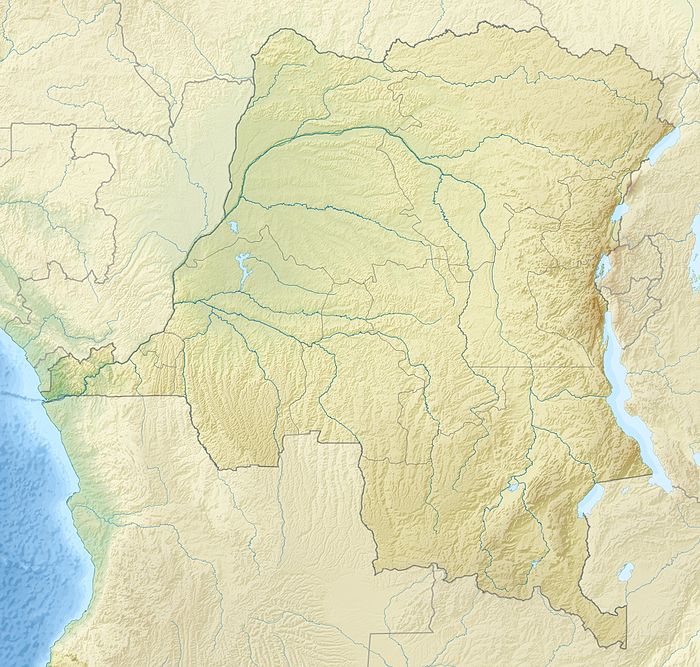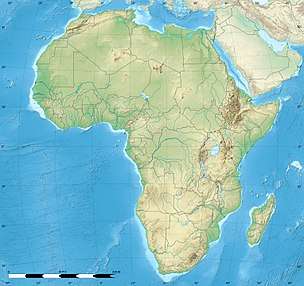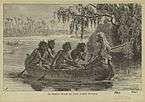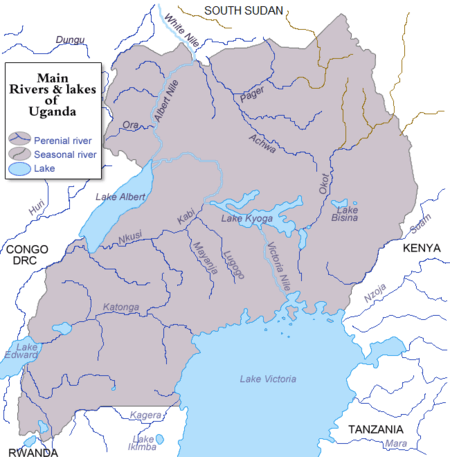Lake Albert (Africa)
Lake Albert, also Mwitanzige and formerly Lake Mobutu Sese Seko, is a lake located in Uganda and the Democratic Republic of the Congo. It is Africa's seventh largest lake, as well as the second biggest of Uganda's Great Lakes.
| Lake Albert | |
|---|---|
_(NASA).jpg) 2002 NASA MODIS satellite picture. The dotted grey line is the border between Congo (DRC) (left) and Uganda (right). | |
 Lake Albert  Lake Albert | |
| Coordinates | 1°41′N 30°55′E |
| Primary inflows | Victoria Nile Semliki River |
| Primary outflows | Albert Nile |
| Basin countries | Democratic Republic of Congo, Uganda |
| Max. length | 160 kilometres (99 mi) |
| Max. width | 30 kilometres (19 mi) |
| Surface area | 5,300 square kilometres (2,000 sq mi) |
| Average depth | 25 metres (82 ft) |
| Max. depth | 51 metres (167 ft) |
| Water volume | 132 cubic kilometres (32 cu mi)[1] |
| Surface elevation | 615 m (2,018 ft) |
| Settlements | Butiaba, Pakwach |
| References | [1] |
Geography
Lake Albert is located in the center of the African continent, on the border between Uganda and the Democratic Republic of the Congo. It is the northernmost of the chain of lakes in the Albertine Rift, the western branch of the East African Rift.
It is about 160 km (100 mi) long and 30 km (19 mi) wide, with a maximum depth of 51 m (168 ft), and a surface elevation of 619 m (2,030 ft) above sea level.
Lake Albert is part of the complicated system of the upper Nile. Its main sources are the White Nile, ultimately coming from Lake Victoria to the southeast, and the Semliki River, which issues from Lake Edward to the southwest. The water of the Victoria Nile is much less saline than that of Lake Albert. The lake’s outlet, at its northernmost tip, is the Albert Nile section of the White Nile. The river later becomes known as the Mountain Nile when its course enters South Sudan.
At the southern end of the lake, where the Semliki comes in, there are swamps. The Rwenzori Mountains are to the south of the lake and to the northwest, the Blue Mountains. The few settlements along the shore include Butiaba and Pakwach.
Water characteristics
Unlike the very deep Lake Malawi, Lake Tanganyika and Lake Kivu, Lake Albert's water temperature is relatively stable throughout, typically around 27–29 °C (81–84 °F), and even its deeper sections contain oxygen.[2]
The water has a pH of around or just below 9 and an electric conductivity of around 720–780 μS/cm. These are both very high for a freshwater lake but nevertheless lower than Lake Edward.[3]
Animals
Lake Albert is home to many aquatic and semi-aquatic animals like hippopotamuses, Uganda kob antelopes, Nile crocodiles, Nile monitors, African softshell turtles, Central African mud turtles, Williams' mud turtles, various semi-aquatic snakes and various frogs.[2] Water birds are numerous and include pelicans, herons and the rare shoebill.[4]
Fish and fishing
There are 55 fish species in Lake Albert.[5] Except for Nile crocodiles, the largest predators in the lake are the Nile perch (native, unlike in other Rift Valley lakes where introduced and invasive), elongate tigerfish, African tigerfish, marbled lungfish, cornish jack, Bagrus docmak, African sharptooth catfish and vundu catfish.[2] Others that support important fisheries are Nile tilapia, Niger barb, Albert lates, electric catfish and giraffe catfish that are caught by standard fishing methods,[5] and the small Brycinus nurse and Engraulicypris bredoi that mainly are caught by light fishing.[6] As much as 30% of the fish production in Uganda is from Lake Albert.[5]
Lake Albert has fewer endemics than the other African Great Lakes.[7] Although the Albert Nile–the section of the Nile that leaves Lake Albert—has several rapids in the Nimule region,[8] these have not effectively isolated the lake from the main Nile sections.[7] In contrast, Lake Edward (and ultimately Lake George) is effectively isolated from Lake Albert by the rapids on the Semliki River, while Lake Kyoga (and ultimately Lake Victoria) is effectively isolated from Lake Albert by the Murchison Falls on the Victoria Nile.[7][8] As a consequence, most of Lake Albert's fish are widespread riverine species also found in the main Nile sections. There are few haplochromine cichlids; a group that is very diverse in other Rift Valley lakes. Of the six haplochromines in Lake Albert, four are endemic (Haplochromis albertianus, H. avium, H. bullatus and H. mahagiensis) and two are also found in the Nile (H. loati and Pseudocrenilabrus multicolor). In comparison, most of the more than 60 haplochromines in Lake Edward–George and most of the roughly 600 haplochromines in Lake Victoria–Kyoga are endemic.[7] The only other endemic fish species in Lake Albert are the small cyprinid Engraulicypris bredoi and the endangered Albert lates.[7]
History
Lake Albert was previously known as “Mwitanzige” (locusts killer) by the Banyoro and Batooro, as well as other peoples who have been populated the region for centuries before the colonial age. This was because of the ancient belief that locusts (locally called "enzige") perished in the lake as they tried to cross it. In 1864, the explorers Samuel Baker and Sass Flóra found the lake[9] and renamed it after the recently deceased Prince Albert, consort of Queen Victoria. In the 20th century, Zairian President Mobutu Sese Seko temporarily named the lake after himself.
European colonialists operated shipping on the lake. The British planned shipping on Lake Albert as part of a network of railway, river steamer and lake steamer services linking British interests in Egypt, east Africa and southern Africa. The John I. Thornycroft & Company shipyard at Woolston, Hampshire built the cargo and passenger ship SS Robert Coryndon for this purpose in 1930.[10] She was named after the British Army officer Robert Thorne Coryndon, who was governor of Uganda 1918-22.[11] Winston Churchill described the ship as "the best library afloat" and Ernest Hemingway called her "magnificence on water".[11] She either was scuttled in 1962[12] or sank in 1964.[11] She remains unsalvaged and partly submerged in the lake [11][12] at Butyaba landing site. These can still be seen to date.
Heritage Oil and Tullow Oil have announced major oil finds in the Lake Albert basin, with estimates that the multi-billion barrel field will prove to be the largest onshore field found in sub-saharan Africa for more than twenty years.[13]
In March 2014, a boat carrying Congolese refugees capsized in Lake Albert, killing more than 250 people.[14]
On 26 December 2016, a boat carrying 45 members and fans of a local village football team capsized in Lake Albert killing at least 30 people.[15]
The Kibiro settlement on Lake Albert has cultural and archeological significance.[16]
Gallery
 Sir Samuel exploring the lake
Sir Samuel exploring the lake Rivers and lakes of Uganda
Rivers and lakes of Uganda.jpg) Ferry
Ferry.jpg) Channel
Channel.jpg) Giraffe by the lake
Giraffe by the lake
See also
References
- The Nile Archived 2007-10-06 at the Wayback Machine
- Green, J. (2009). "Nilotic Lakes of the Western Rift". In H.J. Dumont (ed.). The Nile. Monographiae Biologicae. 89. Springer Science + Business Media B.V. pp. 263–286. ISBN 978-1-4020-9725-6.
- Talling, J.F. (2009). "Physical and Chemical Water Characteristics". In H.J. Dumont (ed.). The Nile. Monographiae Biologicae. 89. Springer Science + Business Media B.V. pp. 367–394. ISBN 978-1-4020-9725-6.
- "Ramsar Sites". ugandawildlife.org. Retrieved 21 September 2019.
- Wandera, S.B.; J.S. Balirwa (2010). "Fish species diversity and relative abundance in Lake Albert—Uganda". Aquatic Ecosystem Health & Management. 13 (3): 284–293. doi:10.1080/14634988.2010.507120.
- "The Lake Albert light fishery". National Fisheries Resources Research Institute (Uganda). 2009. Retrieved 21 September 2019.
- Witte, F.; M.J.P. van Oijen; F.A. Sibbing (2009). "Fish Fauna of the Nile". In H.J. Dumont (ed.). The Nile. Monographiae Biologicae. 89. Springer Science + Business Media B.V. pp. 647–676. ISBN 978-1-4020-9725-6.
- Dumont, H.J. (2009). "A Description of the Nile Basin, and a Synopsis of Its History, Ecology, Biogeography, Hydrology, and Natural Resources". In H.J. Dumont (ed.). The Nile. Monographiae Biologicae. 89. Springer Science + Business Media B.V. pp. 1–21. ISBN 978-1-4020-9725-6.
- Dorothy Middleton (2004). "Baker [née von Sass], Florence Barbara Maria, Lady Baker (1841–1916)". Oxford Dictionary of National Biography. Oxford University Press. Retrieved 2015-09-11.
- Jitze Couperus (2009-04-06). "Jitze Couperus". Biog: The World Biography Project. Archived from the original on 2011-09-10. Retrieved 2011-05-18.
- "Behold, a Dream Unfulfilled". Ugandan Insomniac; Want to sleep, can't sleep. 2009-03-25. Retrieved 2011-05-18.
- "darbykj's photostream". Flickr. 2007-12-09. Retrieved 2011-05-18 – via Yahoo!.
- "Oil & Gas | National Environment Management Authority". www.nema.go.ug. Retrieved 2020-05-30.
- "Uganda Lake Albert boat disaster 'killed 251 refugees'". BBC News. March 27, 2014. Retrieved April 16, 2014.
- "At least 30 drown in Uganda Christmas drama on Lake Albert". MSN. Archived from the original on 2016-12-27.
- "The cultural and chronological context of Kibiro, Uganda".
External links
![]()
- Food and Agriculture Organization of the United Nations
- World Lakes Database entry for Lake Albert
- "East African Railways and Harbours, Marine Services": photos of East African lake ferries including SS Robert Coryndon